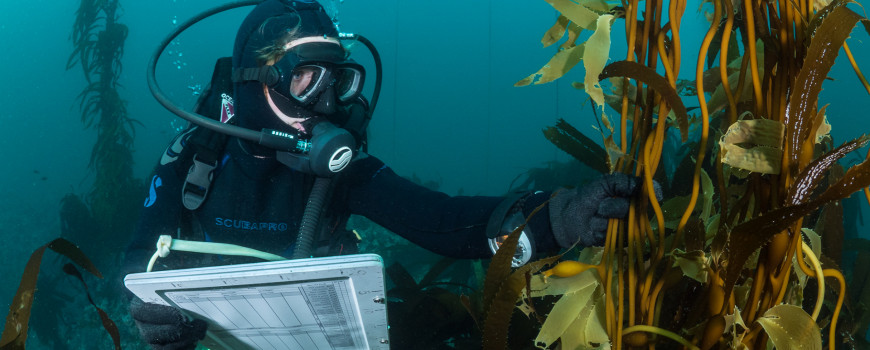After three years, Marine Protected Area Monitoring Program research teams have completed seven long-term projects to gain a better understanding of California’s marine protected areas (MPAs). Teams collected and synthesized past research and utilized a variety of novel scientific approaches for their final reports. These reports will inform the evaluation of California’s MPA network and contribute to the upcoming 2022 decadal management review of the network.
Since 2019, the Ocean Protection Council (OPC) has funded projects totaling $14.8 million through the Marine Protected Area Monitoring Program. These projects were administered by California Sea Grant in partnership with OPC and the California Department of Fish and Wildlife (CDFW). The collaborative projects supported research in California’s network of MPAs and involved researchers from 24 universities, agencies, and institutions across the state. These projects build on more than a decade of monitoring, and include data from the MPA Baseline Monitoring Program, which ran from 2007-2018.
Results showcase the complexities of studying, understanding, and making recommendations for MPAs, while taking into account factors such as the kelp crisis and conducting research during the COVID-19 pandemic. Despite challenges, teams made progress answering MPA network questions spanning diverse topics from ecological, physical, chemical, human use, and climate change impacts, to enforcement metrics used to evaluate the effectiveness of California’s MPAs.
“These projects provide a critical source of information leading to the first MPA decadal management review and reflect the state’s commitment to long-term monitoring and adaptive management of the MPA network,” said Stephen Wertz, California Department of Fish and Wildlife MPA Management Project Supervisor.
The results and recommendations gleaned from the completed MPA long-term monitoring projects are one part of the information gathering needed to understand the effectiveness of California’s MPA network. California’s 124 MPAs span the state’s 1,100-mile coastline and protect 852 square miles (16%) of state waters. Individual MPAs have varying levels of protection, including reserves that encompass 9% of state waters and prohibit all “take” within their boundaries. California’s MPA network is the largest of its kind in North America and one of the largest ecologically connected networks in the world. These results, combined with research dating back to the creation of the MPA network in 2012, will help to inform the future of California’s MPAs.
“The excellent research and synthesis efforts from some of the top coastal marine scientists in the nation will be instrumental in the state’s decadal management review of the California MPA network,” said Mark Gold, Executive Director of the Ocean Protection Council
The California marine protected area long term monitoring program final reports 2019-2021 are now available online. The links below contain project result summaries and the final report PDFs.
- All California marine protected area long term monitoring program final reports 2019-2021
- Establishing a statewide baseline and long-term MPA monitoring program for commercial and CPFV fisheries in the state of California
- Monitoring and evaluation of kelp forest ecosystems in the MLPA marine protected area network
- Evaluating the performance of California’s MPA network through the lens of sandy beach and surf zone ecosystems
- California Collaborative Fisheries Research Program – monitoring and evaluation of California marine protected areas
- Assessment of rocky intertidal habitats for the California marine protected area monitoring program
- Integrated ocean observing systems for assessing marine protected areas across California
- Monitoring and evaluation of mid-depth rocky reef ecosystems in the MLPA marine protected area
###
About The Ocean Protection Council
As a Cabinet-level state policy body nested within the California Natural Resources Agency, OPC advances the Governor’s priorities for coastal and ocean policy and works broadly to advance healthy coastal and ocean ecosystems for current and future generations. OPC’s mission is to protect California’s coast and ocean by advancing innovative, science-based policy and management, making strategic investments, and catalyzing action through partnerships and collaboration.
About California Department of Fish and Wildlife
California Department of Fish and Wildlife (CDFW) is the Department within the California Natural Resources Agency with designated authority to manage California’s vast array of habitats and species. The Mission of the Department of Fish and Wildlife is to manage California's diverse fish, wildlife, and plant resources, and the habitats upon which they depend, for their ecological values, and their use and enjoyment by the public.

